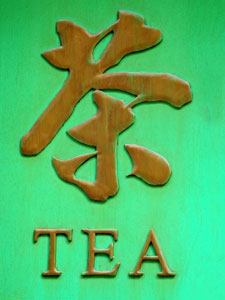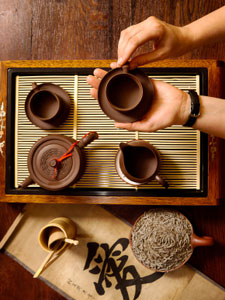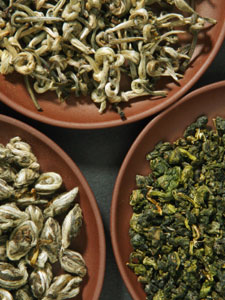Chinese Tea



China is the birthplace of tea and the single largest producer of it in the world. The country remains unrivaled in terms of the varieties produced, with hundreds of teas produced from nearly 350 known cultivars. The best-known provinces for tea are the "Golden Triangle" of Anhui, Zhejiang, and Jiangxi, but many prized and classic tea styles also come from places like Yunnan, Fujian, and Guangdong.
Chinese teas are cultivated in an array of varying terroir, from mountainous cliffs to ancient rainforests. Aside from geography and cultivar, nearly all Chinese teas are finished by the application of dry heat to reduce the moisture content and stop the oxidation process. This is done most often by pan-firing in a large wok or tumble-drying in large drums. Many Chinese tea styles rely on a single, centuries-old tradition — the knowledge of tea master's past.
Chinese tea production differs from that of most other countries in another significant way: the Chinese place an extremely high value on the appearance of the finished leaf. Whether rolled, twisted, curled, flattened or tied up into ornate display teas, the uniform and unique beauty of each tea plays mightily into the perceived value and therefore the price.
The vast majority of tea produced in China is Green. Black teas were developed more recently to suit the Western palate. The Chinese refer to Black tea as hongcha or Red Tea, thanks to the rich, deep color of the liquor.
Famous Chinese Teas
Silver Needle ("Yin Zhen") -Silver Needle is a White tea comprised of only the unopened buds of the China plant. Traditionally from the Fujian province, there are only a few weeks in spring in which this tea can be harvested. It is one the most revered and expensive teas in the world. The cup is usually very light and delicate with sweet vegetal notes and very soft floral aroma. Example: Silver Needle..
Dragonwell ("Long Jing") -Most famous of all Chinese Greens, Dragonwell hails from the West Lake region of Hangzhou. The leaves are pressed into a broad and flat shape during its signature pan-firing. For years, it was reserved as a tribute to Emperors and is praised for its 'four uniques': jade color, vegetative aroma, mellow chestnut flavor and singular shape. Example: Dragonwell.
Gunpowder -Named for the resemblance to its namesake, this tightly rolled Chinese specialty was originally produced to extend the freshness of the tea. With aromatics preserved by the coil, only the outside edges are exposed to the elements. Gunpowder teas tend to be made from medium-grade leaves and offer a lightly roasted, sometimes lightly smoky finish. Example: Gunpowder.
Ti Kuan Yin ("Iron Goddess of Mercy") -Legend has it that the secret to this tea was given as a gift from the goddess to a devout farmer who had tended to her temple for many years. Traditionally produced in Anxi, the titular cultivar this style is made from can be found the world over. There are more than eleven steps involved in its production and variations range from green to dark roasted. Ti Kuan Yin brews a gentle, complex cup, with vegetal and floral notes. Example: Ti Kuan Yin.
Keemun ("Qimen") -This prized black tea style was created when a failed civil servant took up tea farming, venturing to Fujian to learn the secrets of black tea production. Originally, Keemun was one of the primary ingredients of "English Breakfast" tea. The style features small leaves and a rich, smooth flavor with very little astringency. The best Keemuns are produced in Anhui in the early spring. Keemuns often offer notes of dark chocolate, pepper and malt. Example: Keemun Rhapsody.
Yunnan ("Dianhong") -Yunnan refers to a specific Black tea with large, golden tippy leaves. The tea is comprised of the youngest growths from the assamica plant. Its home, The Yunnan province, located in the far south of China, is believed to be the birthplace of tea. These beautiful black teas offer a flavor that is a little softer than Keemuns with a smooth body, honeyed richness and very little astringency. Example: Yunnan Gold.
Lapsang Souchong -Lapsang Souchong is a Black tea that has been literally smoked. Pine wood fires have been used for centuries to provide the heat needed to stop the oxidation process. Lapsang is one of the only teas that is intentionally exposed to the smoke of this fire. Intensely aromatic with savory notes of spices, campfire, peat, and often camphor or eucalyptus. Example: Lapsang Souchong.
Pu-erh -An ancient form of tea, Pu-erhs are unique because they are intentionally aged. They start like typical green teas, only without being finished (they would be very grassy and harshly astringent if you drank them right away), allowing the tea to ferment and age, sometimes many years. There are two main kinds of Pu-Erh, those that have been cooked to stop the aging process (shou) and those that have not (sheng), allowing the buyer to continue to age the leaves. Pu-erhs are often pressed into cakes or bricks, and are known for their pungent, earthy aroma and rich, incredibly smooth taste. Example: Pu Erh Poe.
 teaclass
teaclass
